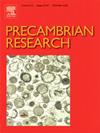U–Pb geochronology of the Malokaroy Series (Kazakhstan) constrains the global appearance of vase-shaped microfossils to > 759 million years ago
IF 3.2
2区 地球科学
Q2 GEOSCIENCES, MULTIDISCIPLINARY
引用次数: 0
Abstract
The appearance of vase-shaped microfossils (VSMs) in the sedimentary record evidences the acquisition of tests by eukaryotes in the late Tonian Period. However, the timing of this biological innovation is uncertain, in part because of a paucity of high-precision radiometric age constraints on VSM-bearing sedimentary successions outside of Laurentia. Here, we investigate the chronostratigraphy of one such succession, the Malokaroy Series in Kazakhstan. The Malokaroy Series was recently interpreted to record deposition in a c. 810–730 Ma continental forearc basin. It includes the Aktugai, Chichkan and Kurgan formations, the middle of which preserves a fossil assemblage with vase-shaped microfossils (VSMs). Outside of Kazakhstan, the appearance of the oldest known VSM taxon is constrained to between 789–752 Ma. The age of the Chichkan assemblage has been variably interpreted, but was recently suggested to be < 737 Ma.
Here, we produce a U–Pb CA-ID-TIMS magmatic zircon age of 759.4 ± 2.5 Ma from an ash collected near the top of the Kurgan Formation. It demonstrates that the top of the Malokaroy Series is ∼ 30 Myr older than most recently suggested and that the Chichkan VSMs are > 759 Ma. We also present zircon trace element ratios from the dated ash consistent with crystallization in an intra-plate setting. Given these data, as well as sedimentological observations, we suggest that the Malokaroy Series records a distinct tectonostratigraphic event, and definitively extend Tonian VSMs to > 759 Ma.
Malokaroy系列(哈萨克斯坦)的U-Pb年代学将花瓶状微化石的全球出现限制在7亿5千9百万年前
沉积记录中花瓶状微化石(VSMs)的出现证明了真核生物在晚托尼期获得了试验。然而,这种生物创新的时间是不确定的,部分原因是缺乏对劳伦西亚以外的含vsm沉积序列的高精度辐射年龄限制。在这里,我们研究了一个这样的演替,即哈萨克斯坦的Malokaroy系列的年代地层。马洛卡罗伊系列最近被解释为记录了约810-730 Ma大陆弧前盆地的沉积。它包括阿克图盖、奇奇坎和库尔干地层,中间保存着一个花瓶状微化石(VSMs)的化石组合。在哈萨克斯坦之外,已知最古老的VSM分类群的出现时间限制在789-752 Ma之间。奇克干组合的年龄一直有不同的解释,但最近被认为是<;737 Ma。在这里,我们从靠近库尔干组顶部的火山灰中获得了759.4±2.5 Ma的U-Pb CA-ID-TIMS岩浆锆石年龄。它表明马洛卡罗伊系列的顶部比最近提出的要早~ 30 Myr,而奇奇坎的vsm是>;759 Ma。我们还提出了锆石微量元素比从年代灰一致结晶在板内设置。根据这些资料和沉积学观察,我们认为马洛卡罗伊系记录了一个独特的构造地层事件,并明确地将东统vsm扩展到>;759 Ma。
本文章由计算机程序翻译,如有差异,请以英文原文为准。
求助全文
约1分钟内获得全文
求助全文
来源期刊

Precambrian Research
地学-地球科学综合
CiteScore
7.20
自引率
28.90%
发文量
325
审稿时长
12 months
期刊介绍:
Precambrian Research publishes studies on all aspects of the early stages of the composition, structure and evolution of the Earth and its planetary neighbours. With a focus on process-oriented and comparative studies, it covers, but is not restricted to, subjects such as:
(1) Chemical, biological, biochemical and cosmochemical evolution; the origin of life; the evolution of the oceans and atmosphere; the early fossil record; palaeobiology;
(2) Geochronology and isotope and elemental geochemistry;
(3) Precambrian mineral deposits;
(4) Geophysical aspects of the early Earth and Precambrian terrains;
(5) Nature, formation and evolution of the Precambrian lithosphere and mantle including magmatic, depositional, metamorphic and tectonic processes.
In addition, the editors particularly welcome integrated process-oriented studies that involve a combination of the above fields and comparative studies that demonstrate the effect of Precambrian evolution on Phanerozoic earth system processes.
Regional and localised studies of Precambrian phenomena are considered appropriate only when the detail and quality allow illustration of a wider process, or when significant gaps in basic knowledge of a particular area can be filled.
 求助内容:
求助内容: 应助结果提醒方式:
应助结果提醒方式:


